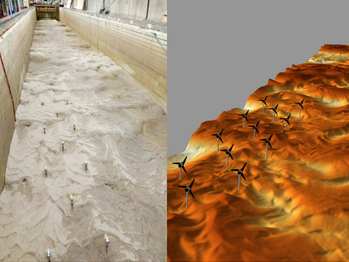Harnessing clean energy from rivers through hydrokinetic turbine arrays

Project Summary
Hydrokinetic turbines are an emerging hydropower technology that take advantage of moving water currents to generate power. Unlike traditional hydroelectric dams that require larger in-channel infrastructure that can disrupt flow and the river ecosystem, hydrokinetic turbines are placed directly in the river channel and have a much smaller environmental footprint. Recent hydrokinetic turbine research has primarily focused on coastal environments, specifically tidal currents. In contrast, very little is known about how these devices would affect a river’s form and behavior, and conversely, how sediment transport and migrating bedforms impact the performance and structural safety of the turbines.
The purpose of this study was to understand how an array of submerged hydrokinetic turbines interacts with a sediment bed and migrating bedforms, through a scaled experiment at the St. Anthony Falls Laboratory. Ultimately, the goal of this research was to inform the use of hydrokinetic turbines in large rivers, like the Mississippi.
Methods
Researchers conducted experiments in SAFL’s main channel with 12 axial-flow turbine models asymmetrically deployed among large migrating dunes. The large size of the main channel and the ability to customize sediment and flow conditions allowed researchers to run a quasi-field scale experiment in an accurate representation of a river bed. The sediment bed was made up of fine sand, which was collected at the channel outlet and recirculated back into the experiment. A SAFL data collection carriage was used to measure various parameters throughout experiments: a Massa ultrasonic sensor was used to measure the flow slope and maintain hydraulic conditions, a non-intrusive optically based measuring system was used to laser scan bedforms and track bathymetric changes, and acoustic Doppler velocimetry was used to measure velocity patterns around the turbine models.
Outcomes
The results suggested that clustering the hydrokinetic turbine array on one side of the river helps minimize disruption of the river’s natural morphodynamics. This makes sense for not only minimizing installation and maintenance costs, but also to preserve other potential uses of the river, like transportation or shipping. Within the array, the hydrokinetic turbines were arranged in a staggered formation, similarly to wind turbines in a wind farm. The resulting distribution of power generation mimicked that of wind farms, despite the introduced complexity of active sediment transport and migrating bedforms in the channel.
This research also demonstrated that when large bedforms such as dunes migrate through the turbine array, continuously operating turbines effectively erode and distort the approaching dune fronts. This prevented burial of the turbine blades and damage to the rotors, ensuring continual energy generation. Thus, these arrays could be resilient through flooding events under very intense sediment transport conditions.
Future Work
Future research on hydrokinetic turbines could include device performance, lifetime testing and morphodynamic resilience of the channel bed and streambanks.
